Yellow Submarine (film)
7.4 /10 1 Votes
Country United Kingdom | 7.4/10 IMDb Genre Animation, Adventure, Comedy Duration Language English | |||||||||||||||||||||||||||||||||
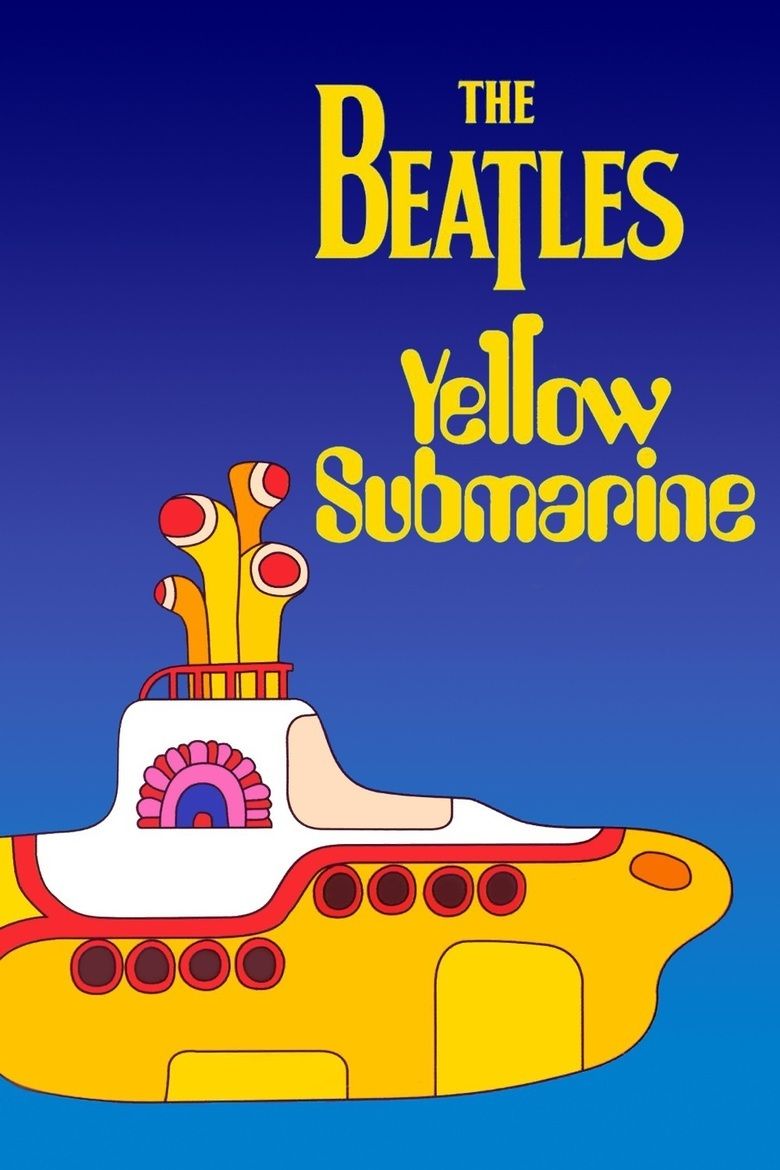 | ||||||||||||||||||||||||||||||||||
Release date 17 July 1968 (1968-07-17) Writer Lee Minoff (story), Lee Minoff (screenplay), Al Brodax (screenplay), Jack Mendelsohn (screenplay), Erich Segal (screenplay) Initial release July 17, 1968 (United Kingdom) Songs Cast (as themselves), (Chief Blue Meanie (voice)), (Ringo (voice)), Uwe Friedrichsen (Ringo (Stimme)), Martin Hirthe (Chef der Blaumiesen (Stimme))Similar movies Taylor Swift & Def Leppard: CMT Crossroads , Kiss: Monster Tour in Zurich , Whitesnake: Made in Japan , Bon Jovi: Live on VH1 Unplugged , Kiss: Rock the Nation Live , Kiss: MTV Unplugged Tagline Nothing Is Real. | ||||||||||||||||||||||||||||||||||
The beatles yellow submarine
Yellow Submarine (also known as The Beatles: Yellow Submarine) is a 1968 British animated musical fantasy comedy film inspired by the music of the Beatles, directed by animation producer George Dunning, and produced by United Artists and King Features Syndicate. Initial press reports stated that the Beatles themselves would provide their own character voices; however, aside from composing and performing the songs, the real Beatles participated only in the closing scene of the film, while their cartoon counterparts were voiced by other actors.
Contents
- The beatles yellow submarine
- The beatles yellow submarine trailer
- Plot
- Voice cast
- Development
- Animation
- Music
- Musical numbers
- Reception
- Home media
- Restoration
- Soundtrack
- Awards and honours
- Cancelled remake
- In popular culture
- References
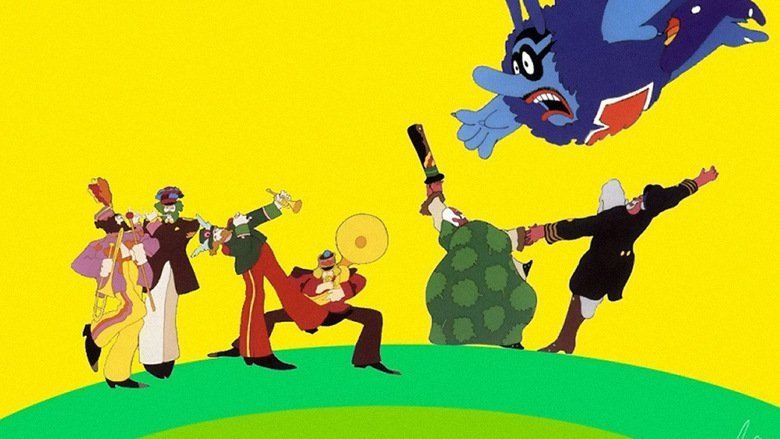
The film received widespread acclaim from critics and audiences alike, in contrast to some of the Beatles' previous film ventures. It has also been credited with bringing more interest in animation as a serious art form. Time commented that it "turned into a smash hit, delighting adolescents and aesthetes alike".
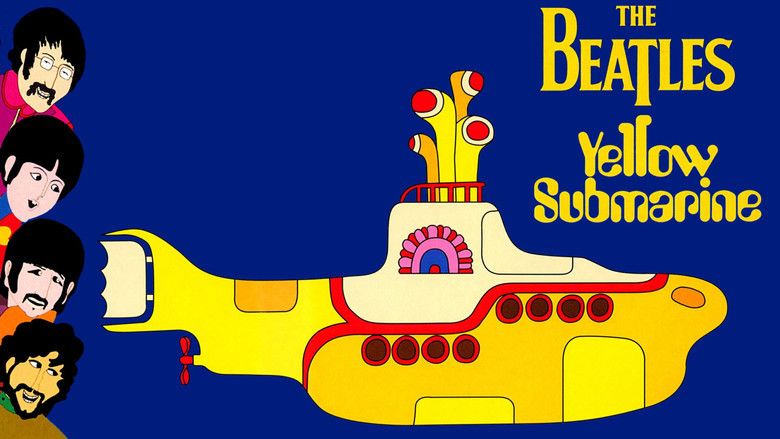
The beatles yellow submarine trailer
Plot
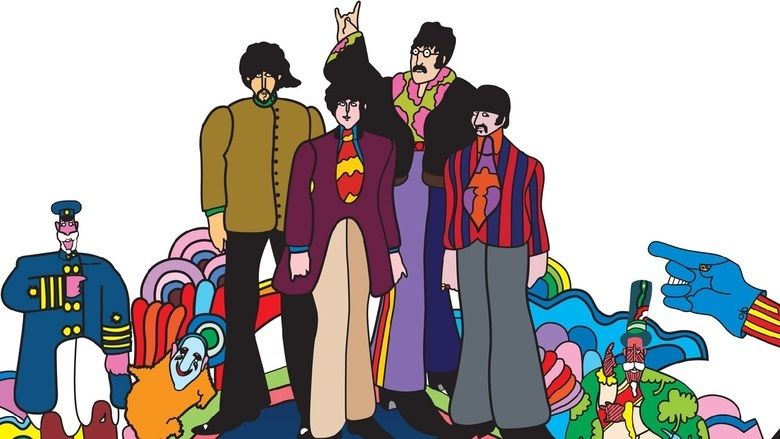
Pepperland is a cheerful, music-loving paradise under the sea, protected by Sgt. Pepper's Lonely Hearts Club Band. The titular Yellow Submarine rests on an Aztec-like pyramid on a hill. At the edge of the land is a range of high blue mountains.
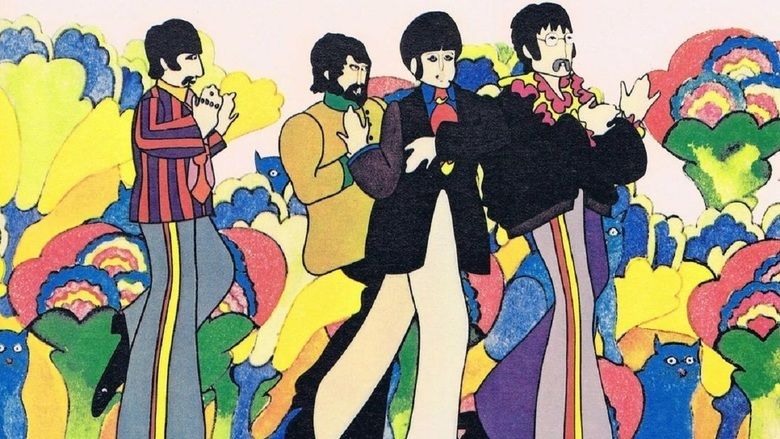
The land falls under a surprise attack from the music-hating Blue Meanies, who live beyond the blue mountains. The attack starts with magical projectiles fired from big artillery stationed in the blue mountains. The Blue Meanies seal the band inside a music-proof blue glass globe, they render the Pepperlanders immobile as statues by shooting arrows or dropping giant green apples upon them (a reference to the Apple Records music label), and drain the entire countryside of colour.
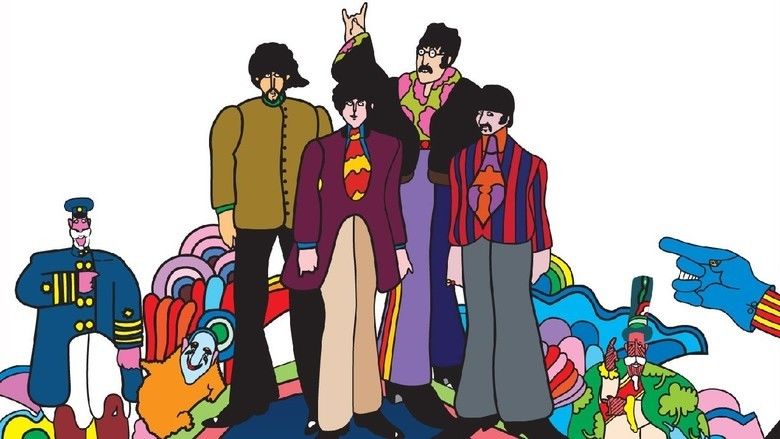
In the last minutes before his capture, Pepperland's elderly Lord Mayor sends Old Fred, an aging sailor (whom the mayor calls "Young Fred"), to get help. Fred activates the Yellow Submarine and takes off in it ("Yellow Submarine"). Old Fred travels to Liverpool ("Eleanor Rigby"), where he follows a depressed Ringo and persuades him to return to Pepperland with him. Ringo collects his "mates" John, George, and finally Paul in The Pier, a house-like building on the top of a hill. The five journey back to Pepperland in the yellow submarine. As they start learning to operate the submarine, they sing "All Together Now", after which they pass through several regions on their way to Pepperland:

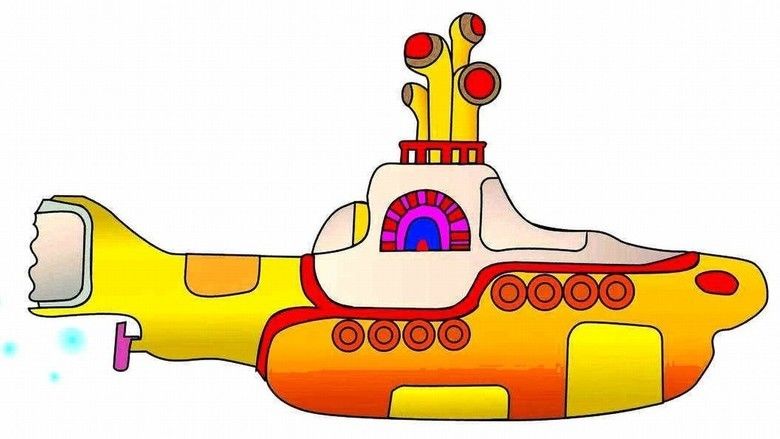
Reunited with Old Fred and the submarine, they look upon the landscape: a sorry sight. The beautiful flowers have become thorns, and the once-happy landscape now a barren wasteland. Everyone is immobilized and made miserable by the evil Blue Meanies, only able to move when permitted (such as when the Meanies feel like bullying them). The Beatles, camouflaged as Pepperlandian cutouts, dress up as Sergeant Pepper's Lonely Hearts Club Band and steal some instruments (their own instruments were lost in the Sea of Monsters) from the warehouse where the Meanies impounded "all things that make music". The four are discovered at the last second (Ringo accidentally steps on a bagpipe) and a clown Meanie sounds the alarm, causing the Beatles to flee hastily from the Meanies' vicious multi-headed (and multi-bodied) dog. Once in the clear, after defeating some apple-bonkers, the four rally the land to rebellion, singing "Sgt. Pepper's Lonely Hearts Club Band", eventually forcing the Blue Meanies to retreat. The Chief Blue Meanie retaliates, sending out his main enforcer, the Dreadful Flying Glove, but John easily defeats it by singing "All You Need is Love". Pepperland is restored to colour and its flowers re-bloom, as the residents, empowered by the Beatles' music, rise up and take up arms (flowers) against the Meanies, who are fleeing headlong back to the blue border mountains where they came from. The original Sgt. Pepper's Lonely Hearts Club Band are released (thanks to the hole carried in Ringo's pocket from the Sea of Holes) and Ringo rescues Jeremy. The Beatles then have a rematch with the four-headed Meanie dog, singing "Hey Bulldog", with the Beatles victorious once again (This scene was in the UK version). The Blue Meanies are forced to retreat, and the Chief Blue Meanie tries to save face by killing Jeremy, but Jeremy performs some "transformation magic" on him causing the Meanie to sadly concede defeat. John extends an offer of friendship, and the Chief Blue Meanie has a change of heart (partly due to the "transformation magic" performed by Jeremy) and accepts. An enormous party ensues, where everyone sings "It's All Too Much" with everyone living happily ever after.
At the end, we see the real Beatles in live-action, having returned home, playfully showing off their souvenirs: George has the submarine's motor, Paul has "a little 'LOVE'" and Ringo still has half a hole in his pocket (having supposedly given the other half to Jeremy, which Paul offers to fix "to keep his mind from wandering", a reference to "Fixing a Hole"). Looking through a telescope, John announces that "newer and bluer Meanies have been sighted within the vicinity of this theatre" and claims there is only one way to go out: "Singing!" The quartet obliges with a short reprise of "All Together Now", which ends with translations of the song's title in various languages appearing in sequence on the screen, which concludes with the words "Released through United Artists" on the bottom-right-hand-corner of the screen.
Voice cast
Sources:
Cast notes
Development
The Beatles were not enthusiastic about participating in a new motion picture, having been dissatisfied with their second feature film, Help! (1965), directed by Richard Lester. They saw an animated film as a favourable way to complete their commitment to United Artists for a third film, however. Many have assumed that a cartoon did not satisfy the contract, but Let It Be (1970) was not connected to the original three-picture deal the Beatles made with United Artists.
The Beatles make a live-action cameo appearance in the final scene, which was filmed on 25 January 1968, shortly before the band's trip to India. This was to fulfill their contractual obligation of actually appearing in the film. The cameo was originally intended to feature a post-production psychedelic background and effects, but because of time and budget constraints, a blank, black background remained in the final film. While Starr and McCartney still looked the same as their animated counterparts, Lennon and Harrison's physical appearances had changed by the time the cameo was shot. Both were clean-shaven, and Lennon had begun to grow his hair longer with accompanying mutton chop sideburns.
The original story was written by Lee Minoff, based on the song by John Lennon and Paul McCartney, and the screenplay penned by four collaborators including Erich Segal. The George Harrison character's recurring line "It's all in the mind" is taken from The Goon Show.
As with many motion picture musicals, the music takes precedence over the actual plot, and most of the story is a series of set pieces designed to present Beatles music set to various images, in a form reminiscent of Walt Disney's Fantasia (and foreshadowing the rise of music videos and MTV thirteen years later). Nonetheless, the film still presents a modern-day fairy tale representing the values of its intended hippie audience.
The dialogue is littered with puns, double entendres, and Beatles in-jokes. In the DVD commentary track production supervisor John Coates states that many of these lines were written by Liverpudlian poet Roger McGough.
In the DVD commentary track, Coates states that the Meanies were always intended to be coloured blue. However, Millicent McMillan recalls that the Blue Meanies were originally supposed to be red, or even purple, but when Heinz Edelmann's assistant accidentally changed the colours, the film's characters took on a different meaning. Coates acknowledges in the commentary that the "are you Bluish? You don't look Bluish" joke in the film is a pun on the then-contemporary expression "you don't look Jewish", but that it was not intended to be derogatory.
Animation
The Beatles' animated personas were based on their appearance in the promotional film for the song "Strawberry Fields Forever", with the exception of Paul being without his moustache. The film also includes several references to songs not included in the soundtrack, including "A Day in the Life", where the lyrics are referenced in the "Sea of Holes" scene, as well as the orchestral breaks earlier in the film, also from "A Day in the Life".
National and foreign animators were assembled by TVC. American animator Robert Balser and Jack Stokes were hired as the film's animation directors. Charlie Jenkins, one of the film's key creative directors, was responsible for the entire "Eleanor Rigby" sequence, as well as the submarine travel from Liverpool, through London, to splashdown. Jenkins also was responsible for "Only a Northern Song" in the Sea of Science, plus much of the multi-image sequences. A large crew of skilled animators, including (in alphabetical order) Alan Ball, Ron Campbell, John Challis, Hester Coblentz, Geoff Collins, Rich Cox, Duane Crowther, Tony Cuthbert, Malcolm Draper, Paul Driessen, Cam Ford, Norm Drew, Tom Halley, Dick Horne, Arthur Humberstone, Dennis Hunt, Greg Irons, Dianne Jackson, Anne Jolliffe, Dave Livesey, Reg Lodge, Geoff Loynes, Lawrence Moorcroft, Ted Percival, Mike Pocock and Gerald Potterton, were responsible for bringing the animated Beatles to life. The background work was executed by artists under the direction of Alison de Vere and Millicent McMillan who were both background supervisors. Ted Lewis and Chris Miles were responsible for animation cleanup.
George Dunning, who also worked on the Beatles cartoon series, was the overall director for the film, supervising over 200 artists for 11 months. "Lucy in the Sky with Diamonds" was Dunning's idea, which he turned over to Bill Sewell, who delivered more than thirty minutes of rotoscoped images. By that time, Dunning was unavailable, and Bob Balser, with the help of Arne Gustafson, edited the material to its sequence length in the film.
The animation design of Yellow Submarine has sometimes been incorrectly attributed to famous psychedelic pop art artist of the era Peter Max, but the film's art director was Heinz Edelmann. Edelmann, along with his contemporary Milton Glaser, pioneered the psychedelic style for which Max would later become famous, but according to Edelmann and producer Al Brodax, as quoted in the book Inside the Yellow Submarine by Hieronimus and Cortner, Max had nothing to do with the production of Yellow Submarine.
The film's surreal visual style, created by creative director Heinz Edelmann, contrasts greatly with the efforts of Disney Feature Animation and other animated films previously released by Hollywood up until the time. The film uses a style of limited animation. It also paved the way for Terry Gilliam's animations for Do Not Adjust Your Set and Monty Python's Flying Circus (particularly the Eleanor Rigby sequence), as well as the Schoolhouse Rock vignettes for ABC and similar-looking animation in early seasons of Sesame Street and The Electric Company. (As such, only one of the animation staff of Yellow Submarine did indeed contribute subsequent animation to Children's Television Workshop: Ron Campbell.)
Music
In addition to the 1966-released title song "Yellow Submarine", several complete or excerpted songs, four previously unreleased, were used in the film. The songs included "All Together Now"; "It's All Too Much", written by Harrison; "Baby, You're a Rich Man", which had first appeared as the B-side to "All You Need Is Love", in June 1967; "Only a Northern Song", a Harrison composition originally recorded during sessions for Sgt. Pepper's Lonely Hearts Club Band; and "Hey Bulldog". Written by Lennon, this last track was cut from the film when it opened in US cinemas. "Hey Bulldog" was restored for the US theatrical and home video reissue in 1999. The four new songs used on the soundtrack album were not considered of high enough quality for appearance on a "regular" Beatles album.
The film's instrumental music was an orchestral score composed and arranged by George Martin. One of the film's cues, heard after the main title credits, was originally recorded during sessions for "Good Night" (a track on The Beatles, also known as the White Album) and would have been used as the introduction to Starr's White Album composition "Don't Pass Me By". The same cue was later released as "A Beginning" on the 1996 compilation Anthology 3.
Musical numbers
All tracks written by Lennon–McCartney except where noted.Track start and end time is indicated in hrs.mins.secs. These are approximated because the songs are embedded in the film plot and cannot be strictly separated.- 0.00.21–0.02.15: "Introduction Story" music by George Martin
- 0.07.55–0.10.40: "Yellow Submarine"
- 0.10.40–0.13.30: "Eleanor Rigby"
- 0.19.00–0.19.55: "Love You To" (George Harrison) (excerpt, played during George's entrance)
- 0.22.30–0.23.05: "A Day in the Life" (excerpt, orchestral swell, starting as the Submarine takes off)
- 0.23.25–0.25.55: "All Together Now"
- 0.28.20–0.31.15: "When I'm Sixty-Four"
- 0.31.30–0.34.30: "Only a Northern Song" (Harrison)
- 0.43.15–0.46.15: "Nowhere Man"
- 0.48.00–0.51.30: "Lucy in the Sky with Diamonds"
- 0.54.30–0.54.50: "Sea of Green" (a short vocal excerpt when Ringo finds the green hole that leads to Pepperland)
- 0.56.15–0.56.25: "Think for Yourself" (Harrison) (short excerpt, a line is sung a cappella to revive the Lord Mayor)
- 1.06.35–1.08.50: "Sgt. Pepper's Lonely Hearts Club Band"
- 1.08.50–1.09.05: "With a Little Help from My Friends" (short excerpt, directly following "Sgt. Pepper's Lonely Hearts Club Band" without interruption, just as on the 1967 album of the same name)
- 1.11.45–1.15.05: "All You Need Is Love"
- 1.16.30–1.16.40: "Baby, You're a Rich Man" (excerpt, played as Sgt. Pepper's Lonely Hearts Club Band are, thanks to Ringo's "hole in his pocket", set free from the anti-music bubble; the recording of the song is expanded for the American-released version, and the scene with the expansion of the recording of the song leads to a scene that replaces the "Hey Bulldog" sequence due to the latter sequence being "anti-climactic".)
- 1.17.25–1.21.00: "Hey Bulldog" Originally shown only in Europe before the film's 1999 restoration.
- 1.24.15–1.27.15: "It's All Too Much" (Harrison)
- 1.27.15–1.29.00: "All Together Now" (accompanied by images of the real Beatles singing, numbers and letters, and "all together now" translated in various languages)
The original soundtrack album comprised the four original Beatles songs, two other Beatles songs (the title song and All You Need Is Love), and orchestral pieces by George Martin.
The orchestral pieces were also used in the short NASA Apollo 9 mission film, which NASA made for every mission.
Another soundtrack was released in 1999, which contained all of the Beatles' songs from the film except "A Day in the Life".
Reception
Yellow Submarine received widespread critical acclaim. The film was distributed worldwide by United Artists in two versions. Released in the midst of the psychedelic pop culture of the 1960s, the film was a box-office hit, drawing in crowds both for its lush, wildly creative images, and its soundtrack of Beatles songs. The version shown in Europe included an extra musical number, "Hey Bulldog", heard in the final third of the film. For release in the United States, the number was replaced with alternative animation due to time constraints. It was felt that at the time, American audiences would grow tired from the length of the film. Of all the Beatles films released by UA, this had been the only one to which UA retained the rights, leading up to its purchase by Metro-Goldwyn-Mayer in 1981. In 2005, Sony Pictures Entertainment led a consortium that purchased MGM and UA. SPE had handled theatrical distribution for MGM until 2012. Conversely, 20th Century Fox Home Entertainment was responsible for home video distribution when the most recent home video release went out of print.
In The Beatles Anthology, released in the mid-1990s, the three surviving Beatles all admitted that they truly liked the film; regarding their initial non-participation, Harrison, who considered it a "classic", later admitted that he preferred that the group did not provide their own voices, feeling that the professional voice actors captured a certain "cartoonish" element far more effectively than they might have done themselves. Starr also revealed that for years he was approached by children and asked "Why did you press the button?", referring to when his character curiously pressed the panic button ejecting him from the submarine into the sea of monsters. Lennon also implied that his son, Sean, first realised his father had been a Beatle because of the film. After seeing Yellow Submarine at a friend's house at the end of the 1970s, Sean came home asking why his father was a cartoon.
On Rotten Tomatoes, the film currently holds a 96% "Certified Fresh" score based on 47 reviews, with an average rating of 7.8/10. The site's consensus states: "A joyful, phantasmagoric blend of colorful animation and the music of the Beatles, Yellow Submarine is delightful (and occasionally melancholy) family fare."
Home media
With the dawn of the home video era came an opportunity to release Yellow Submarine on VHS and LaserDisc. However, it was held up for some years due to music-rights issues that UA had to clear in order for the film to be issued on video by what was then MGM/UA Home Video in 1987. This was presented in its US theatrical release (without the "Hey Bulldog" scene), with a simulated stereo mix of the film's original mono soundtrack. After a couple of years, the video was pulled from release, and for many years copies of the initial home video pressing were considered collectables.
In 1999, then-rights holders MGM and Apple re-issued the film using restoration techniques of the time, the sound remixed to Dolby 5.1, and the film re-edited to its European theatrical version with the "Hey Bulldog" number restored. This version (released through MGM Home Entertainment) has since gone out of print as the rights reverted to Apple Corps.
Restoration
On 20 March 2012, Apple announced that the film had been restored by hand for DVD and Blu-ray release on 28 May (29 May in North America), later delayed one week to 4 June (5 June in North America). In a released statement, the company stated: "The film's soundtrack album will be reissued on CD on the same date. The film has been restored in 4K digital resolution for the first time – all done by hand, frame by frame." The delicate restoration was supervised by Paul Rutan Jr. and his team which included Chris Dusendschon, Rayan Raghuram and Randy Walker. No automated software was used to clean-up the film’s repaired and digitised photo-chemical elements. The work was done by hand, a single frame at a time by 40 to 60 trained digital artists over several months.
In addition to the DVD and Blu-ray re-release, the restored version also received a limited theatrical run in May 2012.
Soundtrack
In 1999, United Artists and Apple Records digitally remixed the audio of the film for a highly successful theatrical and home video re-release. Though the visuals were not digitally restored, a new transfer was done after cleaning the original film negative and rejuvenating the colour. A soundtrack album for this version was also released, which featured the first extensive digital stereo remixes of Beatles material.
The previous DVD release also featured a "soundtrack only" version, in which the dialogue is removed, leaving only the music and the songs. As aforementioned, the MGM disc is out of print and the film's rights have reverted to Apple who reissued the film in June 2012 on DVD and Blu-ray.
Awards and honours
Cancelled remake
In August 2009, Variety reported that Walt Disney Pictures and director Robert Zemeckis were negotiating to produce a 3D computer animated remake of the film. Motion capture would be used, as with Zemeckis' previous animated films The Polar Express, Beowulf, and A Christmas Carol. Variety also indicated that Disney hoped to release the film in time for the 2012 Summer Olympics in London. Disney and Apple Corps officially announced the remake at the inaugural D23 Expo on 11 September 2009.
Comedian Peter Serafinowicz was cast to voice Paul, Dean Lennox Kelly as John, Cary Elwes as George, and Adam Campbell as Ringo. California-based Beatles tribute band, The Fab Four was cast to do the motion capture performance for the animated Beatles.
In May 2010, Disney closed Zemeckis' digital film studio, ImageMovers Digital, after the successful yet unsatisfactory box office performance of A Christmas Carol. On 14 March 2011, Disney abandoned the project, citing the disastrous opening weekend results of Simon Wells' Mars Needs Moms. Criticism towards motion capture technology was also a factor.
In popular culture
References
Yellow Submarine (film) WikipediaYellow Submarine (film) IMDb Yellow Submarine (film) themoviedb.org
